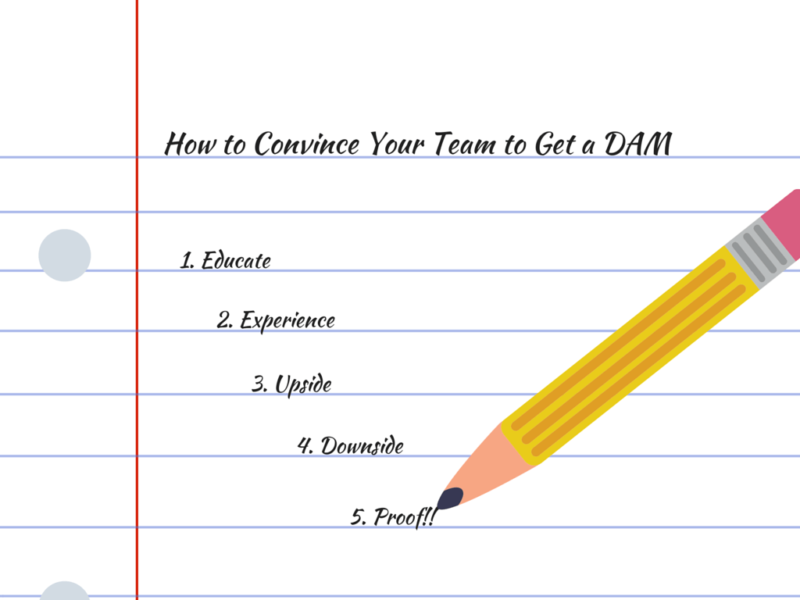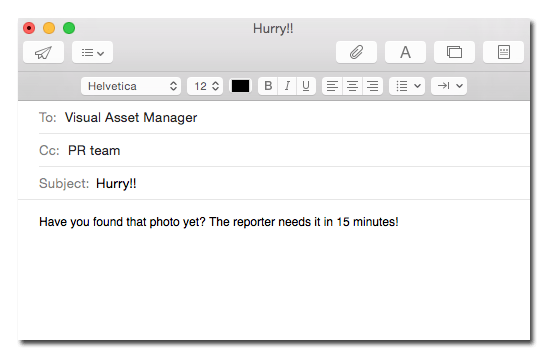Does this situation sound familiar?
You’re sitting on a mess of photos and videos. When someone asks you how your asset library is organized, you shake your head and let out a cynical laugh. You dread requests for images. Searching is a chore. You miss opportunities because you can’t deliver images fast enough, and along the way you have to deal with frustrated colleagues and impatient reporters. Sharing video files with external partners requires driving a hard drive across town.
And the worst part? You know the answer to your problems is digital asset management, but you can’t convince your team to invest in a solution.
If you’re looking at your screen and shouting, “Yes! That’s me!” then don’t worry. You’re not alone. We know a lot of people who have fought the same battle you’re fighting, and we’ve asked them for tips on how to convince your team to get a DAM. With these strategies in your arsenal, you’ll be on your way to a streamlined workflow and a day without lost images, file size limits and angry coworkers.
Educate: Teach your team about DAM and what it can do
Include your team in a demonstration
When you’re shopping for a DAM system, you’ll check out demos of different products. Include your team from the get-go, or when you find a system you like, schedule a second demo with your whole team. A demo will help your team see a system’s best features, and help them understand the benefits.
Document
Keep track of situations when your team would have benefitted from having a DAM.
Think about:
- Missed PR or social media opportunities when you were too slow to share content
- Times when you were on a deadline and your image delivery was excruciatingly slow
- Frustrated emails you got from coworkers who were waiting impatiently for you to find the image they requested forever ago
Reminding them of real situations where a DAM system would have had an impact can help your team see how it could improve their workflow in the future.
Experience: Immerse your team in the DAM workflow ASAP
Seize the moment
Whenever your team is affected by a workflow challenge, seize the moment.
After a tight photo delivery deadline you missed (or almost missed), share with your team how a DAM system would have helped you meet the deadline, without the stress.
After a grueling meeting searching for the perfect photo, explain how a DAM system would make searching and collaborating easier for everyone.
Don’t wait until a pitch meeting for a DAM system to have these conversations. Sharing DAM’s benefits in the moment will be far more impactful.
Some teammates who are affected by these challenges will want to fight in your corner. When they have an issue, ask them to write an email to the decision makers outlining the challenge and encouraging them to consider a DAM.
Make the most of a free trial
Include your team in the free trial process. Make sure they are using the system to the fullest and realizing its value.
Treat this time like a free head start, rather than a trial. Upload a ton of photos and videos, not just a small sample. Creating a robust library from the get-go will help you and your team get a real feel for the system.
Your goal is to show your team why they can’t live without digital asset management, and the trick is hands-on practice. If your team uses the system enough during the trial and gets accustomed to its benefits, they won’t want to give it up.
Upside: Share with your team the benefits of a DAM
Speed
Remind your colleagues that a DAM system would allow them to search for images on their own, and they wouldn’t have to wait for you to fill their requests. Plus, metadata searching makes finding visual assets faster for everyone, so you’ll all be able to deliver images on a tight deadline.
Control
When your teammates have access to your image library, they have more control. Instead of choosing from a handful of images you might set aside for them, they can search full galleries and pick their favorites. (You also have control over what your teammates are allowed to see and download, but shhh! We don’t have to tell them that part.)
Revenue
Your visual assets are valuable for a number of reasons. If your organization is producing photos and videos that your audience might like to purchase, you could be sitting on a potential revenue stream. For example, university sports photographers shoot photos for the school’s website, social media, and promotional materials. When they build a photo store where fans can buy prints to hang on their walls, they can make a huge return on work they’re already producing. The key to ecommerce is organization. Make sure you’re using the best software for your needs. In terms of web hosting for an ecommerce, high-traffic websites like ecommerce sites should be hosted on dedicated servers. This means that the website will be able to cope with high levels of traffic and will maintain a good speed. If you don’t know much about ecommerce software, do some research and check out something like this samcart review. That should help your ecommerce business to thrive more, increasing sales and customers hopefully. When increasing sales and customers, it’s important that your ecommerce business has an easy payment option for customers to safely checkout and purchase their products. Perhaps more online businesses might want to look into international credit card processing payment methods. That should ensure customers have a positive transaction experience, as well as allowing international customers to pay for their products. Additionally, there are other types of software that can make the day to day running of a business easier as well. For example, HR departments can use Payroll Software to make managing the financial side of a business much easier. Ultimately, embracing technology can help businesses to combat delays and maximize performance. Similarly, digital asset management makes organization and ecommerce possible, and in turn, ecommerce can more than cover the cost of digital asset management.
Downside: Share with your team the dangers of living without a DAM
The Fear Tactic
Law suits, lost content, and hoarders, oh my! The dangers of going without a DAM can scare any naysayers into giving it a chance.
- Usage rights: If you don’t have a system for tracking usage rights for a visual asset, you run the risk of violating your agreement with the copyright holder (and even facing a lawsuit).
- Lost valuable assets: When you don’t have a centralized library, photos and videos can get lost in inboxes, hard drives and desktops. If they’re not backed up, they could be gone forever. Some visual assets can be reproduced (for a duplicate cost), but others are irreplaceable (photos of special occasions, historical images).
- Content hoarders: If team members produce content in silos and don’t share visual assets with each other, your organization is wasting time and money. Don’t let your team become overrun by content hoarders.

Proof: Show your team how other organizations are using and benefiting from DAM
Share best practices
Do your research. Sharing DAM best practices with your team can help support your case, and show that you are invested in making the process work seamlessly.
Here are some stories to get you started:
- The 5 Questions You Should Ask When Sharing Photos
- Keywords: A Better Way to Organize and Access Your Photo Library
- A Cost-effective Approach to Photo and Video Management
Use examples
Sometimes you need backup. Get referrals from other organizations that use DAM. Ask them to share why DAM made a difference and why they would recommend it for your organization. Find case studies to share with your team. Anecdotes can help your team imagine how DAM could impact their own workflow.
Check out these case studies:





